"Estimates of the world's oil reserves have risen faster than production."
Oil is a nonrenewable resource. Every gallon of petroleum burned today is unavailable for use by future generations. Over the past 150 years, geologists and other scientists often have predicted that our oil reserves would run dry within a few years. When oil prices rise for an extended period, the news media fill with dire warnings that a crisis is upon us. Environmentalists argue that governments must develop new energy technologies that do not rely on fossil fuels. The facts contradict these harbingers of doom:
- World oil production continued to increase through the end of the 20th century.
- Prices of gasoline and other petroleum products, adjusted for inflation, are lower than they have been for most of the last 150 years.
- Estimates of the world's total endowment of oil have increased faster than oil has been taken from the ground.
How is this possible? We have not run out of oil because new technologies increase the amount of recoverable oil, and market prices – which signal scarcity – encourage new exploration and development. Rather than ending, the Oil Age has barely begun.
[page]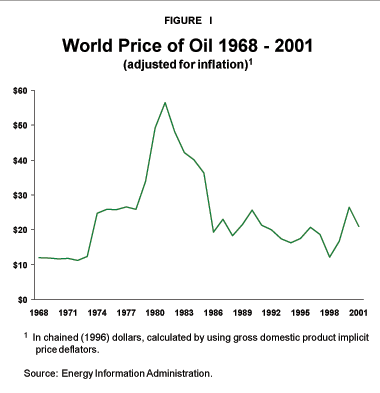
The history of the petroleum industry is punctuated by periodic claims that the supply will be exhausted, followed by the discovery of new oil fields and the development of technologies for recovering additional supplies. For instance:
- Before the first U.S. oil well was drilled in Pennsylvania in 1859, petroleum supplies were limited to crude oil that oozed to the surface. In 1855, an advertisement for Kier's Rock Oil advised consumers to "hurry, before this wonderful product is depleted from Nature's laboratory."1
- In 1874, the state geologist of Pennsylvania, the nation's leading oil-producing state, estimated that only enough U.S. oil remained to keep the nation's kerosene lamps burning for four years.2
"Warnings of U.S. oil shortages were made before the first well was drilled in 1859."
Seven such oil shortage scares occurred before 1950.3 As a writer in the Oil Trade Journal noted in 1918: At regularly recurring intervals in the quarter of a century that I have been following the ins and outs of the oil business[,] there has always arisen the bugaboo of an approaching oil famine, with plenty of individuals ready to prove that the commercial supply of crude oil would become exhausted within a given time – usually only a few years distant.4
1973 Oil Embargo.
"After the revolution in Iran, oil prices returned to the long-term average of $10 to $20 a barrel, in real terms."
The 1973 Arab oil embargo gave rise to renewed claims that the world's oil supply would be exhausted shortly. "The Oil Crisis: This Time the Wolf Is Here," warned an article in the influential journal Foreign Affairs.5 Geologists had cried wolf many times, acknowledged the authors of a respected and widely used textbook on economic geology in 1981; "finally, however, the wolves are with us." The authors predicted that the United States was entering an incipient 125-year-long "energy gap," projected to be at its worst shortly after the year 2000.6
The predictions of the 1970s were followed in a few years by a glut of cheap oil:
- The long-term inflation-adjusted price of oil from 1880 through 1970 averaged $10 to $20 a barrel.7
- The price of oil soared to over $50 a barrel in inflation-adjusted 1996 U.S. dollars following the 1979 political revolution in Iran.8 [See Figure I.]
- But by 1986, inflation-adjusted oil prices had collapsed to one-third their 1980 peak.9
When projected crises failed to occur, doomsayers moved their predictions forward by a few years and published again in more visible and prestigious journals:
"When projected shortages failed to appear, doomsayers made new predictions."
- In 1989, one expert forecast that world oil production would peak that very year and oil prices would reach $50 a barrel by 1994.10
- In 1995, a respected geologist predicted in World Oil that petroleum production would peak in 1996, and after 1999 major increases in crude oil prices would have dire consequences. He warned that "[m]any of the world's developed societies may look more like today's Russia than the U.S."11
- A 1998 Scientific American article entitled "The End of Cheap Oil" predicted that world oil production would peak in 2002 and warned that "what our society does face, and soon, is the end of the abundant and cheap oil on which all industrial nations depend."12
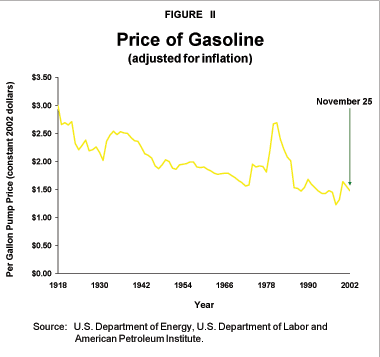
Similar admonitions were published in the two most influential scientific journals in the world, Nature and Science. A 1998 article in Science was titled "The Next Oil Crisis Looms Large – and Perhaps Close."13 A 1999 Nature article was subtitled "[A] permanent decline in global oil production rate is virtually certain to begin within 20 years."14
1990s Oil Glut.
However, rather than falling, world oil production continued to increase throughout the 1990s. Prices have not skyrocketed, suggesting that oil is not becoming more scarce:
- Oil prices were generally stable at $20 to $30 a barrel throughout the 1990s. [See Figure I.]
- In 2001, oil prices fell to a 30-year low after adjusting for inflation.
- Furthermore, the inflation-adjusted retail price of gasoline, one of the most important derivatives of oil, fell to historic lows in the past few years. [See Figure II.]
Nonexperts, including some in the media, persistently predict oil shortage because they misunderstand petroleum terminology. Oil geologists speak of both reserves and resources.
- Reserves are the portion of identified resources that can be economically extracted and exploited using current technology.
- Resources include all fuels, both identified and unknown, and constitute the world's endowment of fossil fuels.
Oil reserves are analogous to food stocks in a pantry. If a household divides its pantry stores by the daily food consumption rate, the same conclusion is always reached: the family will starve to death in a few weeks. Famine never occurs because the family periodically restocks the pantry.
Similarly, if oil reserves are divided by current production rates, exhaustion appears imminent. However, petroleum reserves are continually increased by ongoing exploration and development of resources. For 80 years, oil reserves in the United States have been equal to a 10- to 14-year supply at current rates of development.15 If they had not been continually replenished, we would have run out of oil by 1930.
[page]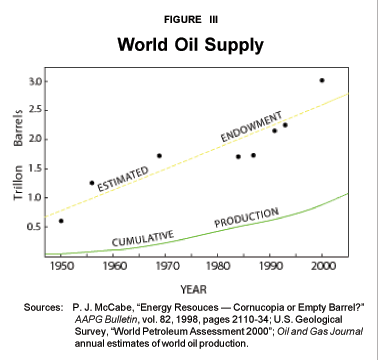
Scaremongers are fond of reminding us that the total amount of oil in the Earth is finite and cannot be replaced during the span of human life. This is true; yet estimates of the world's total oil endowment have grown faster than humanity can pump petroleum out of the ground.16
The Growing Endowment of Oil.
Estimates of the total amount of oil resources in the world grew throughout the 20th century [see Figure III].
- In May 1920, the U.S. Geological Survey announced that the world's total endowment of oil amounted to 60 billion barrels.17
- In 1950, geologists estimated the world's total oil endowment at around 600 billion barrels.
- From 1970 through 1990, their estimates increased to between 1,500 and 2,000 billion barrels.
- In 1994, the U.S. Geological Survey raised the estimate to 2,400 billion barrels, and their most recent estimate (2000) was of a 3,000-billion-barrel endowment.
By the year 2000, a total of 900 billion barrels of oil had been produced.18 Total world oil production in 2000 was 25 billion barrels.19 If world oil consumption continues to increase at an average rate of 1.4 percent a year, and no further resources are discovered, the world's oil supply will not be exhausted until the year 2056.
Additional Petroleum Resources.
"Oil shales may hold another 14,000 billion barrels — a 500 year supply."The estimates above do not include unconventional oil resources. Conventional oil refers to oil that is pumped out of the ground with minimal processing; unconventional oil resources consist largely of tar sands and oil shales that require processing to extract liquid petroleum. Unconventional oil resources are very large. In the future, new technologies that allow extraction of these unconventional resources likely will increase the world's reserves.
- Oil production from tar sands in Canada and South America would add about 600 billion barrels to the world's supply.20
- Rocks found in the three western states of Colorado, Utah and Wyoming alone contain 1,500 billion barrels of oil.21
- Worldwide, the oil-shale resource base could easily be as large as 14,000 billion barrels – more than 500 years of oil supply at year 2000 production rates.22
Unconventional oil resources are more expensive to extract and produce, but we can expect production costs to drop with time as improved technologies increase efficiency.
[page]With every passing year it becomes possible to exploit oil resources that could not have been recovered with old technologies. The first American oil well drilled in 1859 by Colonel Edwin Drake in Titusville, Pa. – which was actually drilled by a local blacksmith known as Uncle Billy Smith – reached a total depth of 69 feet (21 meters).
- Today's drilling technology allows the completion of wells up to 30,000 feet (9,144 meters) deep.
- The vast petroleum resources of the world's submerged continental margins are accessible from offshore platforms that allow drilling in water depths to 9,000 feet (2,743 meters).
- The amount of oil recoverable from a single well has greatly increased because new technologies allow the boring of multiple horizontal shafts from a single vertical shaft.
- Four-dimensional seismic imaging enables engineers and geologists to see a subsurface petroleum reservoir drain over months to years, allowing them to increase the efficiency of its recovery.
New techniques and new technology have increased the efficiency of oil exploration. The success rate for exploratory petroleum wells has increased 50 percent over the past decade, according to energy economist Michael C. Lynch.23
[page]Despite these facts, some environmentalists claim that declining oil production is inevitable, based on the so-called Hubbert model of energy production. They ignore the inaccuracy of Hubbert's projections.
Problems with Hubbert's Model.
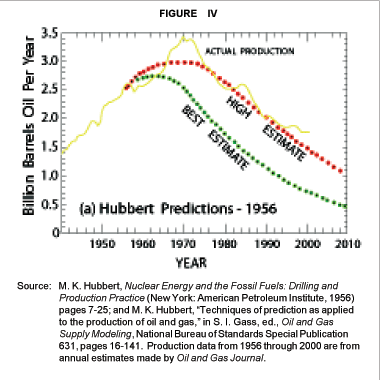
"Environmentalists now tie their predictions of declining energy supplies to M. King Hubbert's model of energy production — which has been consistently inaccurate."In March 1956, M. King Hubbert, a research scientist for Shell Oil, predicted that oil production from the 48 contiguous United States would peak between 1965 and 1970.24 Hubbert's prediction was initially called "utterly ridiculous."25 But when U.S. oil production peaked in 1970, he became an instant celebrity and living legend.
Hubbert based his estimate on a mathematical model that assumes the production of a resource follows a bell-shaped curve – one that rises rapidly to a peak and declines just as quickly. In the case of petroleum, the model requires an accurate estimate of the size of the total oil endowment.26 His best estimate of the size of petroleum resources in the lower 48 states was 150 billion barrels. His high estimate, which he considered an exaggeration, was 200 billion barrels.
Based on these numbers, Hubbert produced two curves showing a "best" estimate of U.S. oil production and a "high" estimate. The claimed accuracy of Hubbert's predictions are largely based on the upper curve – his absolute upper limit [see Figure IV].
- Hubbert set the absolute upper limit for peak U.S. oil production at roughly 3 billion barrels a year, and his best or lower estimate of peak future U.S. crude oil production was closer to 2.5 billion barrels.
- As early as 1970, actual U.S. crude oil production exceeded Hubbert's upper limit by 13 percent.
- By the year 2000, actual U.S. oil production from the lower 48 states was 2.5 times higher than Hubbert's 1956 "best" prediction.
Production in the 48 contiguous states peaked, but at much higher levels than Hubbert predicted. From about 1975 through 1995, Hubbert's upper curve was a fairly good match to actual U.S. production data. But in recent years, U.S. crude oil production has been consistently higher than Hubbert considered possible.
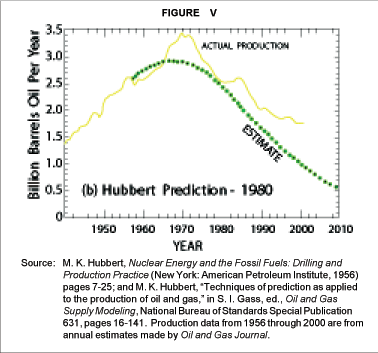
"U.S. oil production has been higher than Hubbert thought possile."
Hubbert's 1980 prediction of U.S. oil production, his last, was substantially less accurate than his 1956 "high" estimate.27 In the year 2000, actual U.S. oil production from the lower 48 states was 1.7 times higher than his 1980 revised prediction [see Figure V].
In light of this, it is strange that Hubbert's predictions have been characterized as remarkably successful. While production in the United States is declining, as Hubbert predicted, it is doing so at a much slower rate. Furthermore, lower production does not necessarily indicate the looming exhaustion of U.S. oil resources. It shows instead that at current prices and with current technology, less of the remaining petroleum is economically recoverable.
Hubbert's Prediction for Natural Gas.
In 1998, Peter McCabe of the U.S. Geological Survey showed that energy resources do not necessarily follow Hubbert-type curves, and even if they do a decline in production may not be due to exhaustion of the resource.28
For example, Hubbert also predicted future U.S. natural gas production. This prediction turned out to be grossly wrong. As of 2000, U.S. natural gas production was 2.4 times higher than Hubbert had predicted in 1956.29
The Production Curve for Coal.
Production of anthracite coal in Pennsylvania through the 19th and 20th centuries followed a Hubbert-type curve more closely than any other known energy resource. Production started around 1830, peaked around 1920, and by 1995 had fallen to about 5 percent of its peak value. However, the supply of Pennsylvania anthracite coal is far from exhausted. If production were to resume at the all-time high rate of 100 million short tons per year, the resource base would support 190 years of production. Production declined not because the resource was depleted but because people stopped heating their homes with coal and switched to cleaner-burning oil and gas.30
"U.S. production in 2000 was 1.7 times higher than Hubbert projected in 1980."
The primary problem with a Hubbert-type analysis is that it requires an accurate estimate of the total resource endowment. Yet estimates of the total endowment have grown systematically larger for at least 50 years as technology has made it possible to exploit petroleum resources previously not considered economical. Hubbert-type analyses of oil production have systematically underestimated future oil production. This will continue to be the case until geologists can produce an accurate and stable estimate of the size of the total oil endowment.
[page]In the long run, an economy that utilizes petroleum as a primary energy source is not sustainable, because the amount of oil in the Earth's crust is finite. However, sustainability is a misleading concept, a chimera. No technology since the birth of civilization has been sustainable. All have been replaced as people devised better and more efficient technologies. The history of energy use is largely one of substitution. In the 19th century, the world's primary energy source was wood. Around 1890, wood was replaced by coal. Coal remained the world's largest source of energy until the 1960s when it was replaced by oil. We have only just entered the petroleum age.31
"Without innovation, no technology is sustainable."
How long will it last? No one can predict the future, but the world contains enough petroleum resources to last at least until the year 2100. This is so far in the future that it would be ludicrous for us to try to anticipate what energy sources our descendants will utilize. Over the next several decades the world likely will continue to see short-term spikes in the price of oil, but these will be caused by political instability and market interference – not by an irreversible decline in supply.
David Deming of the University of Oklahoma's School of Geology and Geophysics is an Adjunct Scholar with the NCPA.
[page]- E. D. Porter, "Are We Running Out of Oil?" API Discussion Paper No. 081, 1995, American Petroleum Institute.
- Ibid.
- Ibid.
- L. M. Fanning, "A Case History of Oil-shortage Scares," in Our Oil Resources, 2nd Ed., L. M. Fanning, ed. (New York: McGraw-Hill, 1950), pages 306-406.
- J. Akins, "The Oil Crisis: This Time the Wolf Is Here," Foreign Affairs, April 1973.
- M. L. Jensen and A. M. Bateman, 1981, Economic Mineral Deposits, 3rd Ed. (New York: John Wiley, 1981), page 593.
- BP Statistical Review of World Energy, British Petroleum, June 2002. Available at http://www.bp.com/genericsection.do?categoryId=92&contentId=7005893.
- Table 5.19, "Crude Oil Refiner Acquisition Costs, 1968-2001," Energy Information Administration, U.S. Department of Energy, available at http://www.eia.doe.gov/emeu/aer/txt/ptb0519.html.
- BP Statistical Review of World Energy.
- C. Campbell, "Oil Price Leap in the Early Nineties," Noroil, December 1989, pages 35-38.
- L. F. Ivanhoe, "Future World Oil Supplies: There Is a Finite Limit," World Oil, vol. 216, 1995, pages 77-88.
- C. J. Campbell and J. H. Laherrère, "The End of Cheap Oil," Scientific American, vol. 278, 1998, pages 78-83.
- R. A. Kerr, "The Next Oil Crisis Looms Large – and Perhaps Close," Science, vol. 281, 1998, pages 1128-31.
- C. B. Hatfield, "Oil Back on the Global Agenda," Nature, vol. 387, 1997, page 121.
- P. J. McCabe, "Energy Resources – Cornucopia or Empty Barrel?" AAPG Bulletin, vol. 82, 1998, pages 2110-34.
- Ibid.
- Ibid.
- See McCabe, "Energy Resources – Cornucopia or Empty Barrel?" p. 2118, for cumulative world oil production through 1995. For annual world oil production, 1996-2000, see Table 2.2, "World Crude Oil Production, 1991-2000," Energy Information Administration, U.S. Department of Energy, available at http://www.eia.doe.gov/emeu/iea/table22.html.
- Oil and Gas Journal, vol. 99, December 24, 2001, p. 127.
- David Deming, "Oil: Are We Running Out?" in M.W. Downey, J. C. Threet and W. A. Morgan, eds., Petroleum Provinces of the 21st Century, AAPG Memoir 74, 2001, pages 45-55.
- Ibid.
- Porter, "Are We Running Out of Oil?" American Petroleum Institute Discussion Paper No. 081, 1995.
- M. C. Lynch, 2002, "Forecasting Oil Supply: Theory and Practice," Quarterly Review of Economics and Finance, vol. 42, 2002, pages 373-89.
- M. K. Hubbert, "Nuclear Energy and the Fossil Fuels," American Petroleum Institute's Drilling and Production Practice, 1956, pages 7-25.
- Hubbert oral biography, American Institute of Physics, 1989.
- Hubbert was deliberately obscure in describing his methods. The only complete description of his methodology is found in: M. K. Hubbert, "Techniques of Prediction as Applied to the Production of Oil and Gas," in S. I. Gass, ed., Oil and Gas Supply Modeling, National Bureau of Standards Special Publication 631, 1982, pages 16-141.
- Ibid.
- McCabe, "Energy Resources – Cornucopia or Empty Barrel?"
- Table 2.4, "World Dry Natural Gas Production, 1991-2000," Energy Information Administration, U.S. Department of Energy, available at http://www.eia.doe.gov/emeu/iea/table24.html.
- McCabe, "Energy Resources – Cornucopia or Empty Barrel?"
- N. Nakicenovic, A. Grübler and A. McDonald, Global Energy Perspectives (Cambridge: Cambridge University Press, 1998), page 299.